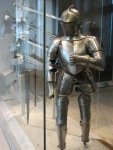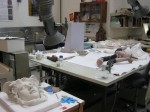The book and paper session was a highlight as I had no prior knowledge. (from a conservation point of view the only reference I had was my collection of american Marvel comics!) This was an interesting one as there are more objects in a collection classed as paper than you would think. Books are the most obvious, but also in the same category are maps, watercolours, house & land deeds, prints, newspapers, posters, wallpaper etc. The question of ‘to glove or not to glove’ comes up again, as using them can mean a possibility of dirt transfer, so clean dry hands it is. If the paper your inspecting is particularly fragile, a ‘bone folder’ can be used.( a folder made of bone, not a device to fold bones…) This cheeky little tool is like a flat blunt knife that is used to slip under the edge of the piece of paper so you aren’t tempted to start scratching away to get hold of the edge, and cause any more damage. (The ‘lick the finger and thumb’ method that people use when reading a newspaper would most likely result in a short sharp visit from the bone folder…)
Monthly Archives: October 2011
The textile session was an in-depth look at different fabrics that can be found in a collection. As there are so many types and compositions, it helps to have a basic understanding of the different composits that can make up a fabric. For example, Velvet can have different grades due to the quality of the material that has been used to create it. On close inspection the weave looks different and a higher quality will feel softer. We also had a great practical task for this session which was to cover the nozzle of a vacuum cleaner with a gauze and clean a piece of fabric. What you are left with when the gauze is removed is a lovely circle of fibres that have been sucked up from the surface of the cloth. This was a perfect example of what can easily happen if a textile is cleaned too harshly which is why some never get cleaned. (it’s better for it to be dusty than to slowly disappear into a vacuum!)
After sometime looking after the house, the time came for my next training course.
This took place where fellow trainee Graham is based, the fantastic Tyntesfield house, which is sort of south-west of Bristol. Having arrived fashionably late because of the rush hour traffic I sneaked in and took my place. The introduction was taken by Helen Lloyd (Conservator to the stars) who helped to write the ‘Manual of Housekeeping’ – the conservation bible. Conservation is primarily the careful management of change. ‘Destiny is Decay… Get used to it!’ Although the core principles of conservation had been explained to me during my initiation ceremony at Dyrham towers, it was helpful to have them re-iterated by Helen. ( I’ll skip the details as I explained the basics in month 1) Having a ceramics specialist Margaret at Dyrham, meant I had a tiny bit of knowledge but the ceramic session was very interesting, and gave us the basics in being able to identify different types of glaze, what type of material was used to make it, before even picking it up. The key to ceramic movement is firstly to analyse what’s in front of you. This is basically to determine if there are any repairs or cracks or damage to take note of before it’s moved. The best way to pick a ceramic up is with clean, dry hands, support from the base, and lift but don’t grip… ‘Complex’ objects (objects with different pieces to them) can be moved bit by bit, but bigger or heavier ceramics will need to be tilted and supported at the back and base and held at a 45 (ish) degree angle, as this avoids any wobbling when lifting.
We also got the chance to go around the museum on our own which was a great opportunity but we only had an hour so I got a good workout trying to see all that I wanted to. It was a truly awesome day, and a rare treat to meet the fantastic staff and get to see conservation work on a massive scale.
Next stop on the tour was a look at the workshops. Among other projects, they cope with all of the packing of objects that come in or go out of the museum, as well as building the exhibitions themselves. While looking around we got a rare treat and were shown an exhibition in it’s infancy. ‘Post-Modernism’ is a display of late 1970’s – 1990’s pop-culture… ( just my era!) The exhibition is designed to re-create the inside of a live music venue and had at the time we were shown round, a suit worn by Annie Lennox, ( who’ll have her own section as well..) and also costumes worn by the B-52’s, ( the band not the bomber…) and Devo.
The tour kicked off with a look at the paper and book departments, who were involved with some fascinating conservation work. Some of which involved re-binding some original works of Charles Dickens. Next stop the textile department, to see the dedicated staff working on some fantastic costumes with painstaking detail. We were then treated to a peek at the stone and plaster workshops, which was fascinating to see conservation on a much grander scale than I had seen before. The sculptures they work on have a range of conservation requirements, and all need to be treated with the utmost care & attention. They have special procedures and solutions for the removal of years of ingrained dirt from mostly porus stone.










